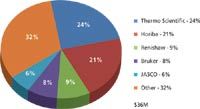Market Profile: Raman Spectroscopy in the Pharmaceutical Industry
Raman spectroscopy has developed into a key analytical tool for the pharmaceutical industry.
Raman spectroscopy has developed into a key analytical tool for the pharmaceutical industry. Both portable and benchtop Raman systems are now widely used for applications in the pharmaceutical industry. Despite a challenging economy, demand from the pharmaceutical industry is holding its own and should return to typical growth rates by next year.

Laboratory and portable Raman - pharmaceutical vendor share, 2012.
Within the pharmaceutical industry, one of the biggest applications now is the identification of incoming raw materials and finished product inspection, for which there are numerous new portable and handheld models available for on-dock or production area analysis. The other major application is the analysis of polymorphs and salt forms in both quality control (QC) and product development, variations of which can lead to dramatically different performance of a pharmaceutical product.
Worldwide demand for laboratory and portable Raman spectroscopy instrumentation from the pharmaceutical industry was about $36 million in 2012. Global economic conditions and major cuts in government spending will clearly make 2013 a challenging year for the overall Raman market. However, the numerous new product introductions and market entrants over the last two years will help keep demand from the pharmaceutical industry in positive territory in 2013, if only slightly, until much stronger growth returns, most likely in 2014.
The foregoing data were extracted from SDi's market analysis and perspectives report titled The Global Assessment Report, 12th Edition: The Laboratory Life Science and Analytical Instrument Industry, October 2012. For more information, visit www.strategic-directions.com

Market Profile: Mass, Molecular, and Atomic Spectroscopy
December 1st 2018Mass spectrometry, molecular and atomic spectroscopy technologies combine to represent more than a fifth of the overall market for laboratory analytical instrumentation. These techniques are perhaps the most broadly used instruments, with utility in pharmaceuticals and other life sciences, chemicals, environmental, food, clinical/Dx and other applications.